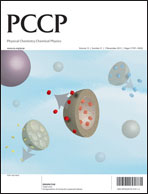Spin crossover complexes [Fe(NH2trz)3](X)2·nH2O investigated by means of polarized Raman scattering and DFT calculations†
Abstract
Vibrational spectra of the spin crossover (SCO) polymers [Fe(NH2trz)3](X)2·nH2O where NH2trz = 4-NH2-1,2,4-triazole and X = Cl, Br, BF4, and NO3 have been analyzed. Our results show that the anions and water molecules have no significant influence on the vibrational properties of the Fe(NH2-trz)3 polymer chains. A detailed study of the nitrate derivative, based on the DFT analysis of the polarized spectra of single crystals, has been undertaken to propose the normal mode assignment of the Raman peaks in the low spin state of the compound. Changes in the Raman spectra in the high spin state could therefore be analyzed and interpreted by several Raman bands identified as molecular probes of the SCO phenomenon. Various factors (laser power, humidity, pressure) that influence the transition temperatures and the hysteresis loops have been identified and adjusted for obtaining reliable measurements. We demonstrate in particular that all the techniques used to probe the phase transition process give comparable results providing that the sample environment is well controlled.
2·nH2O investigated by means of polarized Raman scattering and DFT calculations](/en/Image/Get?imageInfo.ImageType=GA&imageInfo.ImageIdentifier.ManuscriptID=C3CP52505H&imageInfo.ImageIdentifier.Year=2013)

 Please wait while we load your content...
Please wait while we load your content...